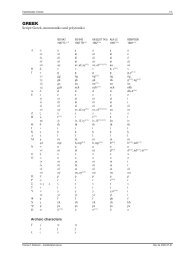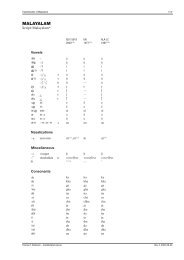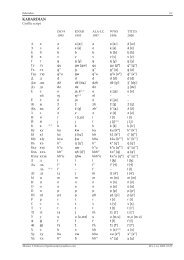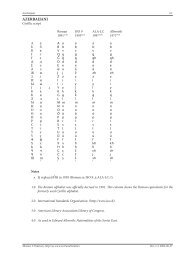Mongolian - Transliteration of Non-Roman Scripts - Eesti Keele ...
Mongolian - Transliteration of Non-Roman Scripts - Eesti Keele ...
Mongolian - Transliteration of Non-Roman Scripts - Eesti Keele ...
Create successful ePaper yourself
Turn your PDF publications into a flip-book with our unique Google optimized e-Paper software.
<strong>Mongolian</strong> 1/7<br />
MONGOLIAN<br />
<strong>Mongolian</strong> (Uighur) script*<br />
Vowels<br />
iso ini med n<br />
Scholary UN ALA-LC Xine Latin Cyrillic<br />
(1.0) 1982 (2.0) 1997 (3.0) (4.0) equiv. (5.0)<br />
ᠠ ᠢ A a a a a а<br />
ᠡ A e e e e э<br />
ᠢ ᠵ ᡞ i i i i и<br />
ᠣ ᠤ B o o o o о<br />
ᠣ ᠤ u u u u у<br />
ᠥ ᠦ ᡡ C ö o, ô (2.1) ȯ oe ө<br />
ᠥ ᡉ ᠦ ᡡ C ü u, û (2.1) u̇ ue ү<br />
ᠧ ᠸ D ē (é) — — — е<br />
Consonants<br />
ᠨ E n n n n н<br />
ᠩ ng (ŋ) — ng ng нг<br />
ᠪ ᠪ ᡋ F b b b b б<br />
ᠫ ᠫ p p p p п<br />
ᠬ ᠭ G q h q h х<br />
ᢉ ᢉ H (k) (1.1) k k х<br />
ᠭ ᠬ I ɣ g ġ g г<br />
ᢉ H (g) (1.1) g g г<br />
ᠮ m m m m м<br />
ᠯ l l l l л<br />
ᠰ S s s s с<br />
ᠱ š x ś x ш<br />
ᠲ ᠳ J t t t t т<br />
ᠲ ᠳ ᠳ K d d d d д<br />
ᠴ č q c q ч<br />
ᠵ ǰ (j) j j j ж<br />
ᠶ ᠵ ᠶ ᠵ y y y y й<br />
ᠷ ᠷ r r r r р<br />
ᠸ ᠸ w (v) w v v в<br />
Thomas T. Pedersen, transliteration.eki.ee Rev. 2, 2006-05-06
<strong>Mongolian</strong> 2/7<br />
iso ini med n<br />
Ligatures<br />
Scholary UN ALA-LC Xine Latin Cyrillic<br />
(1.0) 1982 (2.0) 1997 (3.0) (4.0) equiv. (5.0)<br />
ᠹ ᠹ f f f f ф<br />
ᠺ ᠺ D g (k) — k — к<br />
ᠻ ᠻ D k (kh) — — k к<br />
ᠼ c c — zh ц<br />
ᠽ z z — ch з<br />
ᠾ ᡁ h h h h' х<br />
ᠿ ᠿ ž — — r' ж<br />
ᡀ L lh — — lh лх<br />
ᡁ (zh) — — z' з<br />
ᡂ (ch) — — c' ч<br />
ba, be<br />
bi<br />
bo, bu<br />
bö, bü<br />
D bē<br />
pa, pe<br />
pi<br />
po, pu<br />
pö, pü<br />
D pē<br />
qe, ɣe (ke, ge)<br />
qi, ɣi (ki, gi)<br />
qö, qü, ɣö, ɣü (kö, kü, gö, gü)<br />
D ɣē (gē)<br />
qe (ke)<br />
qi (ki)<br />
qö, qü (kö, kü)<br />
D qē (kē)<br />
fa<br />
fe<br />
fi<br />
fo<br />
fu<br />
fü<br />
fö<br />
D fē<br />
Thomas T. Pedersen, transliteration.eki.ee Rev. 2, 2006-05-06
<strong>Mongolian</strong> 3/7<br />
iso ini med n<br />
D ga (ka)<br />
D ge (ke)<br />
D gi (ki)<br />
D go (ko)<br />
D gu (ku)<br />
D gü (kü)<br />
D gö (kö)<br />
D gē (kē)<br />
D ka (kha)<br />
D ke (khe)<br />
D ki (khi)<br />
D ko (kho)<br />
D ku (khu)<br />
D kü (khü)<br />
D kö (khö)<br />
D kē (khē)<br />
Punctuation Marks<br />
Scholary UN ALA-LC Xine Latin Cyrillic<br />
(1.0) 1982 (2.0) 1997 (3.0) (4.0) equiv. (5.0)<br />
᠀ birga<br />
᠁ ellipsis<br />
᠂ comma<br />
᠃ full stop<br />
᠄ colon<br />
᠅ marks the end <strong>of</strong> a chapter<br />
Numbers<br />
᠐ 0<br />
᠑ 1<br />
᠒ 2<br />
᠓ 3<br />
᠔ 4<br />
᠕ 5<br />
᠖ 6<br />
᠗ 7<br />
᠘ 8<br />
᠙ 9<br />
Thomas T. Pedersen, transliteration.eki.ee Rev. 2, 2006-05-06
<strong>Mongolian</strong> 4/7<br />
Notes<br />
* Character forms: iso isolated form, ini initial form, med medial form, n nal form.<br />
A In general, is used in nal position after all consonants except b, p, and, in foreign<br />
words, k.<br />
B in nal position is used in foreign words.<br />
C ᡡ in medial position is used in the rst syllable, in medial position in the second and<br />
following syllables, in nal position is used in foreign words.<br />
D Used in foreign words.<br />
E in medial position is used before a vowel, in medial position before a consonant,<br />
and in medial position before in word-nal position in certain words.<br />
F ᡋ is an old form.<br />
G in medial position is used before in word-nal position.<br />
H This form is used before e, i, ö and ü. See the Ligatures section for details.<br />
I in medial position is used before a vowel, in medial position before a consonant and<br />
in medial position before in word-nal position.<br />
J in medial and in nal position are used in foreign words.<br />
K in medial position is used before a consonant, ᠳ in initial position is used in foreign<br />
words.<br />
L Used in words borrowed from Tibetan.<br />
1.0 “Scholary” refers to the scientic transliteration used in linguistic works on <strong>Mongolian</strong>.<br />
Forms in parentheses represent alternative equivalents.<br />
1.1 The alternatives k and g should only be used before e, i, ö and ü.<br />
2.0 The United Nations recommended system. The ocial Chinese romanization scheme based on<br />
Pinyin.<br />
2.1 ô and û are used for place names, while o and u are for general use.<br />
3.0 American Library Association/Library <strong>of</strong> Congress.<br />
4.0 “New Latin <strong>Mongolian</strong>” – an attempt to create a unied Latin-based alphabet for the <strong>Mongolian</strong><br />
languages.<br />
5.0 Cyrillic equivalents corresponding to the alphabet used in Mongolia.<br />
Sources<br />
• ALA-LC <strong>Roman</strong>ization Tables: <strong>Transliteration</strong> Schemes for <strong>Non</strong>-<strong>Roman</strong> <strong>Scripts</strong>. Randal K. Berry (ed.).<br />
Library <strong>of</strong> Congress, 1997. (http://lcweb.loc.gov/catdir/cpso/roman.html).<br />
• Cor, Oliver & Dorjpalam Dorj: MonTeX <strong>Mongolian</strong> and Manju for LaTeX2e. Implementation Level<br />
IVu v. IVu.04.092. 2002-07-01. (http://userpage.fu-berlin.de/~cor/im/MLS/montex.html).<br />
• Erdenechimeg, Myatav, Richard Moore, and Yumbayar Namsrai. Traditional <strong>Mongolian</strong> Script in<br />
the ISO/IEC 10646 and Unicode Standards. Technical Report 170, UNU-IIST, P.O.Box 3058, Macau,<br />
August 1999. Presented by Myatav Erdenechimeg at the 16th International Unicode Conference,<br />
Amsterdam, The Netherlands, 27-30 March 2000, and published in the proceedings, Part<br />
1, Section B2, under the title “Encoding and Implementation Issues in Standardising Traditional<br />
<strong>Mongolian</strong> Script”. The Unicode Consortium, March 2000. (ftp://ftp.iist.unu.edu/pub/techreports/report170.tar.gz).<br />
Thomas T. Pedersen, transliteration.eki.ee Rev. 2, 2006-05-06
<strong>Mongolian</strong> 5/7<br />
• Kapaj, Luigi: Writing Mongol in Uighur Script. 2002. (http://www.viahistoria.com/SilverHorde/research/UighurScript.html).<br />
• Monggol heleten. Xine Latin Monggol Uesugiig Nairuulagsan Zaraqim higeed Araga. 2001-05-03.<br />
(http://xjmg.nease.net/lating/Xin%20Latin%20Monggol%20Uesug%20in%20Tohai%20Tanilquul<br />
ga.htm).<br />
• Poppe, Nicholas: Grammar <strong>of</strong> Written <strong>Mongolian</strong>. (Porta Linguarum Orientalum 1). 4th unrev.<br />
printing, Wiesbaden 1991.<br />
• Ramsey, S. Robert: The Languages <strong>of</strong> China. Princeton, 1987.<br />
• Tacoronte, Ariel Laurencio: Alfabeto clásico mongol. 2001-05-01. (http://laurencio.webz.cz/mongolxel/toli/qaguchin/index.htm).<br />
• United Nations <strong>Roman</strong>ization Systems for Geographical Names. Report on Their Current Status.<br />
Compiled by the UNGEGN Working Group on <strong>Roman</strong>ization Systems. Version 2.2. January 2003.<br />
(http://www.eki.ee/wgrs/).<br />
• Эрдэнэчимэг, Мятавын: Монгол бичигийн үсгийн код. 2004-01-16. (http://openmn.sourceforge.<br />
net/modules/Subjects/pages/pdfs/mgl_code.pdf).<br />
Thomas T. Pedersen, transliteration.eki.ee Rev. 2, 2006-05-06
<strong>Mongolian</strong> 6/7<br />
MONGOLIAN<br />
Cyrillic script<br />
ISO 9 KNAB ALA-LC BGN/PCGN<br />
1995 (1.0) 1993 (2.0) 1997 (3.0) 1967 (4.0)<br />
А а a a a a<br />
Б б b b b b<br />
В в v v v v<br />
Г г g g g g<br />
Д д d d d d<br />
Е е e je, é, jö (2.1) e yö<br />
Ё ё ë jo ë yo<br />
Ж ж ž ž zh j<br />
З з z z z dz<br />
И и i i i i<br />
Й й j j ǐ y<br />
К к k k k k<br />
Л л l l l l<br />
М м m m m m<br />
Н н n n n n<br />
О о o o o o<br />
Ө ө ô ö ȯ ö<br />
П п p p p p<br />
Р р r r r r<br />
С с s s s s<br />
Т т t t t t<br />
У у u u u u<br />
Ү ү ù ü u̇ ü<br />
Ф ф f f f f<br />
Х х h h kh h<br />
Ц ц c c t͡s ts<br />
Ч ч č č ch ch<br />
Ш ш š š sh sh<br />
Щ щ ŝ šč shch shch<br />
Ъ ъ A ʺ ʺ ’<br />
Ы ы y y y ï<br />
Ь ь ʹ ĭ ʹ ĭ<br />
Э э è e ė e<br />
Ю ю û ju, jü (2.2) i͡u yu, yü (4.1)<br />
Я я â ja i͡a ya<br />
Thomas T. Pedersen, transliteration.eki.ee Rev. 2, 2006-05-06
<strong>Mongolian</strong> 7/7<br />
Notes<br />
A Occurs only in Russian words.<br />
1.0 International Standards Organisation. (http://www.iso.ch).<br />
2.0 Kohanimeandmebaas (Place Names Database) <strong>of</strong> <strong>Eesti</strong> <strong>Keele</strong> Instituut (Institute <strong>of</strong> the<br />
Estonian Language) (http://www.eki.ee).<br />
2.1 é is used in Russian loan words, jö is used if followed immediately or in the next syllable<br />
by ö.<br />
2.2 jü is used in words with front vowels or before ü.<br />
3.0 American Library Association/Library <strong>of</strong> Congress<br />
4.0 United States Board on Geographic Names and the Permanent Committee on Geographical<br />
Names for British Ocial Use.<br />
4.1 In monosyllables, romanized yu or yü depending on pronounciation; in polysyllables, romanized<br />
yu when followed by a, o or u, but yü when followed by i, e, ö or ü.<br />
Sources<br />
• ALA-LC <strong>Roman</strong>ization Tables: <strong>Transliteration</strong> Schemes for <strong>Non</strong>-<strong>Roman</strong> <strong>Scripts</strong>. Randal K. Berry (ed.).<br />
Library <strong>of</strong> Congress, 1997. (http://lcweb.loc.gov/catdir/cpso/roman.html).<br />
• ISO 9:1995. Information and documentation – <strong>Transliteration</strong> <strong>of</strong> Cyrillic characters into Latin characters<br />
– Slavic and non-Slavic languages. International Organization for Standardization, 1995.<br />
• Kara, György: “Aramaic <strong>Scripts</strong> for Altaic Languanges”, in Peter T. Daniels & William Bright, eds.<br />
The World’s Writing Systems. New York/Oxford, 1996.<br />
• Latiniseeritud nimede hääldusjuhiseid/Guide to the Pronounciation <strong>of</strong> <strong>Roman</strong>ized Names. KNAB: Kohanimeandmebaas.<br />
<strong>Eesti</strong> Keeli Instituut, 1998.<br />
• United Nations <strong>Roman</strong>ization Systems for Geographical Names. Report on Their Current Status.<br />
Compiled by the UNGEGN Working Group on <strong>Roman</strong>ization Systems. Version 2.2. January 2003.<br />
(http://www.eki.ee/wgrs/).<br />
Thomas T. Pedersen, transliteration.eki.ee Rev. 2, 2006-05-06
















